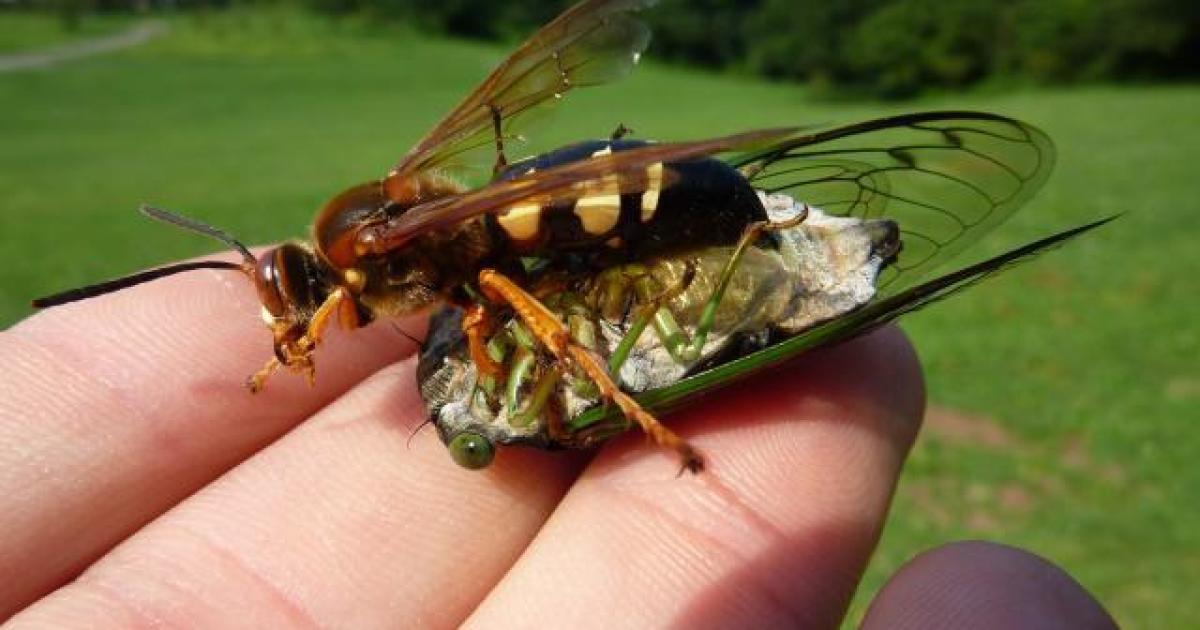Eastern Cicada Killer Wasps

During late July through August Pro-Force Pest Solutions often receives calls about large wasps swarming over lawns; and we know the Eastern Cicada Killer Wasps have hatched. These are often very large cicada killer wasps; these insects will seek out cicadas to serve as food for their larvae. The female cicada killer wasp looks threatening due to their size, which can range in size from 1 ¼ inch to 2 inches. The males of this wasp species are two times smaller than females. Although their unusual size along with their fearsome name would scare anyone they are actually quite harmless.
Cicada killer wasps are large and solitary insects. These robust wasps are hairy, the abdomen, the portion of the body immediately behind the insect’s “thread-waist,” is black with yellow markings on three segments. Their six legs are pale red to orange and the wings are a shaded brown color. Their brownish color wings although resemble the yellowjacket and hornet species do not be fooled!
What months Do The Cicada Killer Wasps Thrive?
- During the months of July through September, they are active and can be seen when the cicadas are most active.
How Did My Home Get Eastern Cicada Killer Wasps?
It is important to look for perfect nesting spots. The eastern cicada killer wasps generally look for areas in full sunlight near trees where cicadas live. They dig tunnels in the ground, causing unsightly damage to flower beds and lawns. It is also important to note that the eastern cicada killer wasps breed rapidly, so populations can quickly become overwhelming. When you notice signs of this happens calling in a professional pest control solutions company will quickly and efficiently help you before to much damage is done.
Are Eastern Cicada Killer Wasps Serious and Will They Sting?
With an average size of a wasp being 1 1/2 half inches long, an eastern cicada killer wasp looks very menacing and scary; however, they are relatively non-aggressive and are not likely to sting unless given no option but to defend themselves. Males are territorial and will dive-bomb if provoked, but they cannot sting thankfully. Females have stingers but don’t defend the nest as aggressively as males do. One would think with a name like Killer Wasp their sting would produce a strong punch to a body, but in fact they produce a very mild venom that is far less painful than the sting of many social wasps, like yellow jackets.
How Do You Get Rid of Eastern Cicada Killer Wasps?
Since these insects are not likely to sting, the homeowner may elect to apply insecticidal dust in and around the burrow entrance when first noticing cicada killer activity in the soil. When choosing to use insecticides, always read, and carefully follow the product’s label directions. If there is a heavy population located in a sensitive public area, the best thing to do is contact your pest management professional for their service.
How Do They Nest and When Do They Emerge?
Cicada Killer Wasps build their nests in the ground. Females dig burrows a foot or so deep where they store adult cicadas that the females have paralyzed by their sting. The eggs are laid on the cicadas which then hatch and the larvae feed on the dead bodies. Fully grown in one week, the larvae pupate into a cocoon, emerging the following summer, which is a complete metamorphosis.
Females sting the cicadas with a paralyzing toxin then hoist the cicada, which is more than twice their own body weight, through the air to their underground burrow in sandy or loose soils. You can also find nests in common areas like the lawn, along driveways and sidewalks, and in flowerbeds where the soil is dry and well-drained. The tunneling is quite extensive also, they bring large amounts of soil to the surface; which can be very unsightly.
They lay one egg on the cicada in a nest chamber at the end of the burrow. A second or sometimes even a third cicada body is often added because female larvae are larger than males and need more food. The chamber is then sealed and the process is repeated until multiple chambers are formed. The egg hatches in one or two days and the larvae consume the cicada meal for five to eight days until it reaches maturity. It then spins a cocoon and overwinters underground, pupating the following spring and hatching in July or August. After emerging from the ground, shortly after cicadas begin to sing, adults live two to six weeks to mate and lay eggs, feeding on flower nectar and plant sap.
How Should You Take Action and Use A Pesticide?
When control is needed, direct a pyrethroid insecticide application to the tunnel or entrance to the tunnel as this has been shown to reduce their activity. Broadcast insecticide applications over large areas have not provided consistent results.
What To Expect When You Call Pro-Force Pest Solutions?
If you see you have an insect issue on your property like the Cicada Killer Wasp and they decided to take up residence on your property, the pest control experts at Pro-Force Pest Solutions can help you eliminate them. Getting rid of cicadas can be challenging since it is important the treatment is timed just right to prevent a re-infestation.
The technicians at Pro-Force Pest Solutions have the experience and knowledge to successfully treat and control these pests. To learn more about our cicada killer wasp control services, contact us today.
